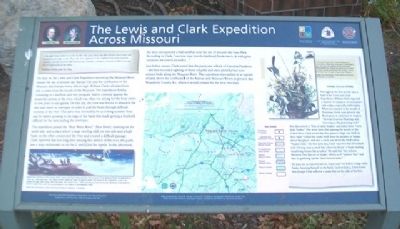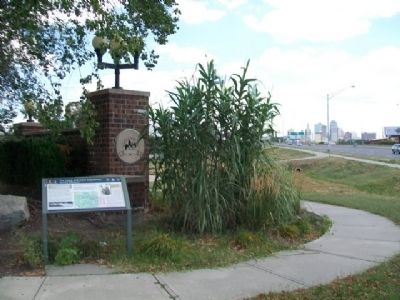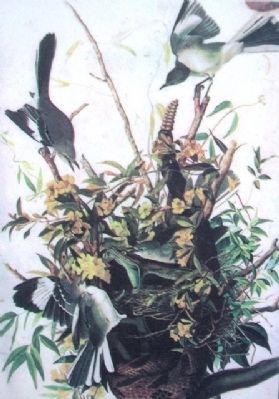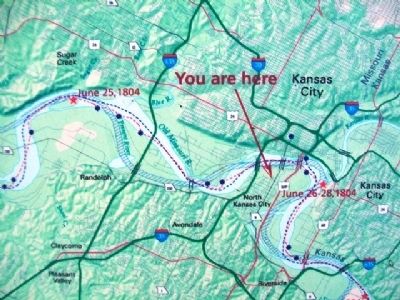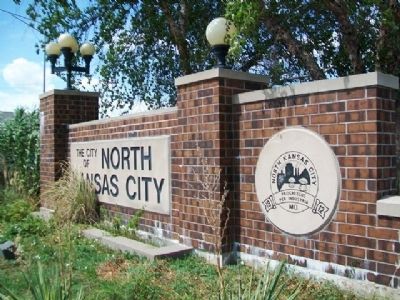North Kansas City in Clay County, Missouri — The American Midwest (Upper Plains)
The Lewis and Clark Expedition Across Missouri
Inscription.
…the high lands which is on the Northe Side [just above the Blue Water river] does not exceed 80 feet high, at this Place the river appears to be Confined in a very narrow channel, and the Current Still more So by Couenter [counter] Current or Whirl on one Side & high bank on the other."
William Clark, June 26, 1804
On June 26, the Lewis and Clark Expedition moved up the Missouri River toward the site of present-day Kansas City and the confluence of the Missouri and Kansas rivers, which Capt. William Clark calculated was 366.75 miles from the mouth of the Missouri. The expedition flotilla, consisting of a keelboat and two pirogues, had to contend against the powerful current of the river, which was often too strong for the boat crews to row, pole or sail against. On this day, the crew was forced to abandon the oars and resort to towropes in order to pull the boats through difficult sections of the river. This labor was intensified by scorching summer heat and by timber growing to the edge of the bank that made getting a foothold difficult for the men pulling the towropes.
The expedition passed the "Blue Water River" (Blue River), entering on the south side, and a place where a large swirling eddy on one side and a high bank on the other constricted the river and created a difficult passage. Clark reported that not long after passing this stretch of the river, the party saw a large rattlesnake on the bank and killed the reptile. In the afternoon, the men encountered a bad sandbar near the site of present-day Case Park. According to Clark, "our tow rope [on the keelboat] broke twice, & with great exertions we rowed around it..."
Just before sunset, Clark noted that the party saw a flock of Carolina Parakeets - the first recorded sighting of these colorful and once plentiful but now extinct birds along the Missouri River. The expedition then pulled in at a point of land above the confluence of the Kansas and Missouri Rivers in present-day Wyandotte County, Ks., where it would remain for the next two days.
Snake Encounters
Throughout the first month-and-a-half of the Lewis and Clark Expedition, William Clark reported a number of instances of encounters with snakes, especially rattlesnakes. When they landed at the mouth of Moniteau Creek, near present-day Rocheport, in early June to inspect "Several Courious Paintings and Carveings in the projecting rock" they discovered a "Den of rattle Snakes" and killed three "very large Snakes." One week later, after passing the mouth of the Grand River, Clark noted that they passed a high clay bluff on their right "Called the Snake bluff from the number of Snakes about this place" and
also a creek just above the bluff called "Snake Creek." On this same day, Clark reported that Drouillard told of being near a small lake where he heard "a Snake making Goubleing Noises like a turkey." He said that "the Indians Mention This Species of Snake," which is of "emence Size" and that its gobbling can be "herd Several miles."
On June 26, as reported above, Clark said "we Killed a large rattle Snake, Sunning himself in the bank," and on July 4, Clark noted that Joseph Field suffered a snake bite on the side of his foot.
[Inset illustration captions read]
Below the entrance to the Kansas River, Lewis and Clark observed that the current of the Missouri River increased to as much as 7 miles per hour. This rapid current made for many occasions where the boats of the expedition had to be pulled through swift water with towropes. This detail from a 1833 painting by Swiss Artist Karl Bodmer illustrates the kind of rapids that could be encountered in this stretch of the Missouri River.
Used with permission, State Historical Society of Missouri, Columbia
In this painting by John James Audubon, a rattlesnake is depicted attacking a mockingbird nest. The journal keepers of the Lewis and Clark Expedition frequently mentioned snakes, or place names associated with snakes, during their journey through present-day Missouri.
Used with permission,
State Historical Society of Missouri, Columbia.
Map prepared by James D. Harlan, University of Missouri Geographic Resources Center, for Lewis and Clark Historic Landscape Project, funded by the Office of Secretary of State
Erected by Missouri Dept of Natural Resources, National Park Service, Missouri Lewis and Clark Bicentennial Commission, and City of North Kansas City.
Topics and series. This historical marker is listed in these topic lists: Exploration • Waterways & Vessels. In addition, it is included in the Lewis & Clark Expedition series list. A significant historical date for this entry is June 26, 1297.
Location. 39° 7.59′ N, 94° 34.815′ W. Marker is in North Kansas City, Missouri, in Clay County. Marker is at the intersection of Burlington Street (Missouri Route 9) and 10th Street, on the left when traveling south on Burlington Street. Touch for map. Marker is in this post office area: Kansas City MO 64116, United States of America. Touch for directions.
Other nearby markers. At least 8 other markers are within walking distance of this marker. Lou E. Holland (approx. 0.7 miles away); Charles B. Wheeler Downtown Airport (approx. 0.7 miles away); Moving Settlers West (approx. 0.7 miles away); Moving Hearts & Minds (approx. ¾ mile away); Moving Indians, Trappers & Traders (approx.
¾ mile away); Moving Water (approx. ¾ mile away); Curran Park (approx. one mile away); Building Through the Bluffs (approx. one mile away).
Also see . . .
1. Lewis and Clark National Historic Trail. National Park Service website entry (Submitted on August 16, 2013, by William Fischer, Jr. of Scranton, Pennsylvania.)
2. Lewis and Clark Across Missouri. Website homepage (Submitted on August 16, 2013, by William Fischer, Jr. of Scranton, Pennsylvania.)
3. Follow In The Footsteps Of Missouri’s First Explorers On This Adventurous Road Trip. Only In Your State website entry (Submitted on April 28, 2022, by Larry Gertner of New York, New York.)
Credits. This page was last revised on April 28, 2022. It was originally submitted on August 16, 2013, by William Fischer, Jr. of Scranton, Pennsylvania. This page has been viewed 727 times since then and 27 times this year. Photos: 1, 2, 3, 4, 5, 6. submitted on August 16, 2013, by William Fischer, Jr. of Scranton, Pennsylvania.
